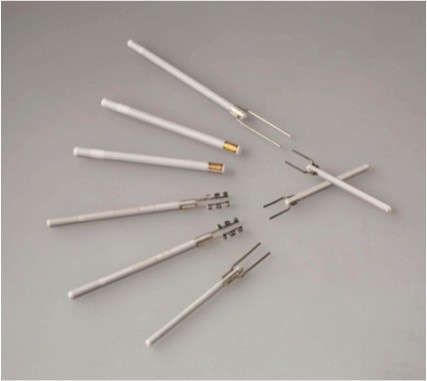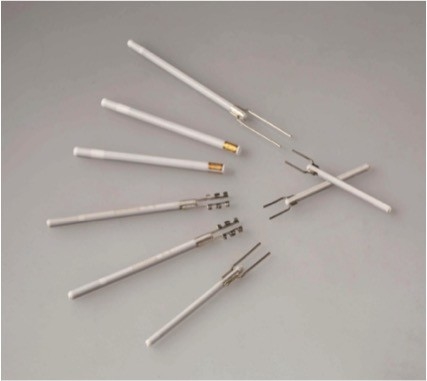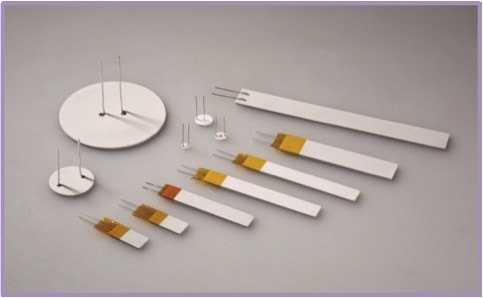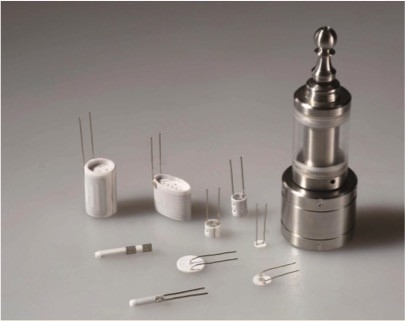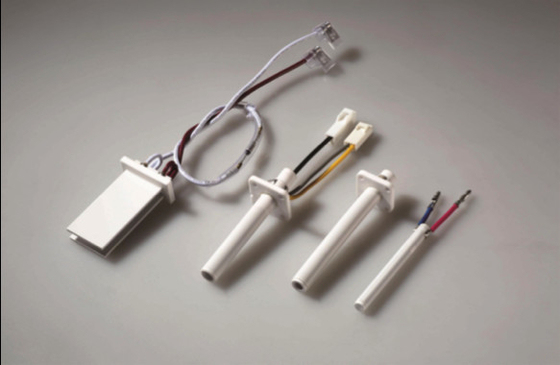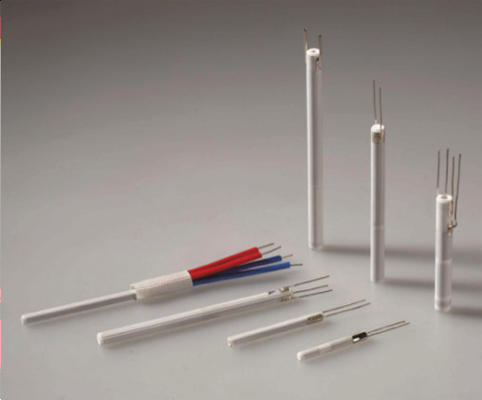Alumina metallic ceramic heating element (HTCC)
Alumina Ceramic Heaters
Introduction:
HTCC is an acronym for High-temperature co-fired ceramics; HTCC ceramic heating element is made up of high melting point metal heating material such as tungsten, molybdenum or molybdenum – manganese and 92-96% alumina ceramic substrates. The metal heating resistance slurry is printed onto the tape casting ceramic green body according to the design requirement, several layers of ceramic green body are then laminated together and is fired at 1500 ~ 1600 ℃ high temperature, with the aid of 4-8% sintering additive, to form the alumina ceramic heating element. This product features in corrosion-resistant, withstanding high temperature, long life cycle, energy efficient, uniform surface temperature, excellent thermal conductivity and thermal compensation rate. Alumina ceramic heating element doesn’t contain harmful substances such like: lead, cadmium, mercury, hexavalent chromium, polybrominated biphenyls, polybrominated diphenyl ethers, etc., and is in compliance with EU RoHS and other environmental requirements.
Background information
With the advent of the integration of electronic components, electronic devices have posed higher demands on circuit miniaturization, high-density, multi-function, high reliability, high speed and large power. Co-fired multi-layer ceramic substrate meets all these requirements so it has been used in a wide range of applications in recent years. Co-fired multi-layer ceramic substrate can be divided into high temperature co-fired ceramic (HTCC) substrate and low temperature co-fired multi-layer ceramic (LTCC) substrate. Compared to LTCC, high temperature co-fired ceramics (HTCC) has higher mechanical strength, higher wiring density, better chemical stability, higher thermal dissipation coefficient and lower cost and is widely used in the heating and packing applications requiring higher thermal stability performance, less high temperature volatile gases and better sealing. High temperature co-fired ceramic heating element is a good alternate of alloy wire and PTC ceramic heating element and component.
Features
- Energy saving, high thermal efficiency
- Surface is not charged, good electric insulation, withstand 4500V/1s, leakage current<0.5mA
- Linear resistance-temperature, easy to control temperature by controlling the electric resistance
- No power decay for a long period
- Rapid heating, a 500W ceramic heating element can reach above 600 ℃ in 20 seconds; its components can reach above 200 ℃ in 10 seconds
- No open flame, safety
- Uniform surface heating
- High power density: ≥ 50 W/cm2
- Environmental Protection: no lead, cadmium, mercury, hexavalent chromium, polybrominated biphenyls, more harmful substances such as polybrominated diphenyl ethers, in full compliance with EU environmental requirements.
Application
- Heat gun
- Hair salon appliance (hair straighteners, curlers)
- Warm air conditioning
- Instantaneous water heater
- Multi-functional microwave, oven, drying
- Clothes dryer
- Hand dryer
- Kettle, coffee maker
Technical parameters
5.1 Appearance:
- Smooth surface
- Neat edge
- Silver electrode
- White ceramic body
- Our "efficient Tape Casting ceramic substrates" technology prepares ultra-thin, ultra-smooth ceramic green body which ensures the smooth surface of the ceramic body. Precision hot press lamination ensures the neat edge. Electrode points are nickel plated and spot welded leads after firing, so the electrodes appear silver.
5.2 Dimension tolerance:
- Length direction: ± 1.2mm
- Width direction: ± 0.5mm
- Thickness direction: ± 0.1.
- After repeated firing experiments, our R & D personnel has collected the green body shrinkage data, and summed up the appropriate rate of contraction based on experimental results. Through careful control of the casting, punching and lamination process, we minimize the size differences between the green body and the firing product.
5.3 Voltage range: DC / AC 5-220V
Depending on the resistance value, alumina ceramic heating element can be used in a wide range of voltage from 5V DC to 220V AC.
5.4 Power density
By optimizing the production formula, ceramic heating element generates the greatest possible power density, from 60W / cm2 in startup stage, to 25W / cm2 in normal use.
5.5 Leakage current <5mA
Rated leakage current <5mA. When applying 1800V/3750V high voltage, leakage current is less than 0.5mA.
5.6 Thermal Shock
The product can withstand thermal shock without cracking when it is heated to 150 ± 10 °C and is placed in water at 20 ℃.
5.7 Electric insulation
When applying 4500V for 1 second, leak current <0.5mA
Material properties
| Properties |
Test condition |
Unit |
Value or performance |
| Color, appearance |
|
|
White, dense |
| Substrate material |
|
|
96% alumina ceramics |
| Density |
|
g/cm3 |
>3.7 |
| Warpage |
|
mm |
<0.2mm |
| Leads tensile strength |
|
kg |
Axial direction ≥5
Across direction≥3
|
| Bending strength |
|
MPa |
>300 |
| Thermal conductivity |
20 ° C |
W/(m.K) |
≥20 |
| Electric insulation strength |
25±1 ° C,110V:1800V/10seconds,220V:4500V/10 seconds |
|
Leakage current <0.5mA |
| Insulation resistance |
DC500V |
MΩ |
>100 |
| Electric resistance |
25±1 ° C |
Ω |
0.4-1000 (or customer made) |
| Cycle time test |
Under rated voltage and general temperature condition (≤ 280 ° C), power on for 60min and then power off for 60min repeatedly |
|
1000 times, no damage |
| Power-on test |
At rated voltage, power on for 20 seconds in the air, the surface temperature of 600 ° C -750 ° C |
|
No damage |
| High-temperature durability test |
At the highest temperature, generally 500-700 ° C, continuously power on |
|
More than 24 hours |

 Your message must be between 20-3,000 characters!
Your message must be between 20-3,000 characters! Please check your E-mail!
Please check your E-mail!  Your message must be between 20-3,000 characters!
Your message must be between 20-3,000 characters! Please check your E-mail!
Please check your E-mail! 
